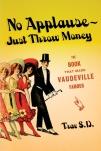Vaudeville (and American culture in general) had many enemies in the early twentieth century, but none more pernicious than syphilis. It took the lives of George Walker, Ernest Hogan and Tony Hart, but when it took the life of Bob Cole (1868-1911), it robbed us of a theatrical Renaissance man clearly destined for a career of great achievements. In reading about him, one can’t help but observe that in whatever professional situation he found himself, he would rapidly rise to be the one of the ones in creative control. It happened several times.
With some college behind him, the Georgia native moved to Chicago in 1889 where he sang, danced and clowned with Sam T. Jack’s Creole Show. Within five years, he was not only one of the principles but directing the productions. There, too, he met his first vaudeville partner (and wife) Stella Wiley.
The pair moved to New York in 1894 and were running a troupe of performers at Worth’s Museum when Cole teamed up with the first of his “Johnsons”, Billy, with whom he performed from 1894 through 1899. The combination sounds a lot like Williams and Walker — Johnson, a former minstrel, played the fast talking con man, Cole played a tramp. They wrote sketches and songs for Black Patti’s Troubadors, but left after a money dispute and created their own show, the hit A Trip to Coon-town.
By the turn of the century, the ambitious Cole seems to have outgrown his partner and began collaborating with a pair of brothers, also named Johnson, and much more up to the scale of his abilities. His performing partner was J. Rosamond Johnson, who played piano and sang harmonies with Cole. Both wore tuxedoes (and no black face) when they performed, and this class act, like Williams and Walker, was among the very first African American acts to play “white” vaudeville. Their behind-the-scenes partner was James Weldon Johnson, later a famous author, poet and U.S. consul to Venezuela. The two Johnsons and Cole wrote songs together in various combinations. Their most famous one today (the one with the most longevity) is “Under the Bamboo Tree”, used so memorably by Steve Martin in The Man with Two Brains. After penning songs for several Klaw and Erlanger shows, the team decided to create their own productions. To raise money, they worked the big time vaudeville circuits. In 1910 Cole collapsed as a result of his venereal disease, and he passed away the following year. The Johnson brothers went on to become major figures in the Harlem Renaissance with decades more of professional triumphs to enjoy. Frankly, they deserve a whole book of their own, their many accomplishments being outside the scope of this little squib about a vaudeville team.
To find out more about these variety artists and the history of vaudeville, consult No Applause, Just Throw Money: The Book That Made Vaudeville Famous, available at Amazon, Barnes and Noble, and wherever nutty books are sold.


